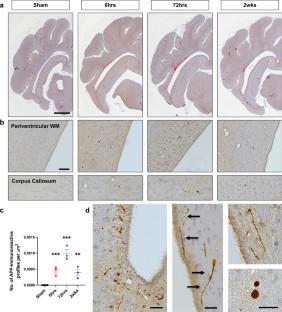Acta Neuropathologica ( IF 9.3 ) Pub Date : 2022-09-15 , DOI: 10.1007/s00401-022-02498-1 Hailong Song 1 , Przemyslaw P McEwan 1 , Kamar E Ameen-Ali 2 , Alexandra Tomasevich 1 , Claire Kennedy-Dietrich 2 , Alexander Palma 1 , Edgardo J Arroyo 1 , Jean-Pierre Dolle 1 , Victoria E Johnson 1 , William Stewart 2, 3 , Douglas H Smith 1

|
Despite being a major health concern, little is known about the pathophysiological changes that underly concussion. Nonetheless, emerging evidence suggests that selective damage to white matter axons, or diffuse axonal injury (DAI), disrupts brain network connectivity and function. While voltage-gated sodium channels (NaChs) and their anchoring proteins at the nodes of Ranvier (NOR) on axons are key elements of the brain’s network signaling machinery, changes in their integrity have not been studied in context with DAI. Here, we utilized a clinically relevant swine model of concussion that induces evolving axonal pathology, demonstrated by accumulation of amyloid precursor protein (APP) across the white matter. Over a two-week follow-up post-concussion with this model, we found widespread loss of NaCh isoform 1.6 (Nav1.6), progressive increases in NOR length, the appearance of void and heminodes and loss of βIV-spectrin, ankyrin G, and neurofascin 186 or their collective diffusion into the paranode. Notably, these changes were in close proximity, yet distinct from APP-immunoreactive swollen axonal profiles, potentially representing a unique, newfound phenotype of axonal pathology in DAI. Since concussion in humans is non-fatal, the clinical relevance of these findings was determined through examination of post-mortem brain tissue from humans with higher levels of acute traumatic brain injury. Here, a similar loss of Nav1.6 and changes in NOR structures in brain white matter were observed as found in the swine model of concussion. Collectively, this widespread and progressive disruption of NaChs and NOR appears to be a form of sodium channelopathy, which may represent an important substrate underlying brain network dysfunction after concussion.
中文翻译:

脑震荡导致广泛的轴突钠通道丢失和 Ranvier 结的破坏
尽管脑震荡是一个主要的健康问题,但人们对脑震荡背后的病理生理变化知之甚少。尽管如此,新出现的证据表明,对白质轴突的选择性损伤或弥漫性轴突损伤 (DAI) 会破坏大脑网络连接和功能。虽然电压门控钠通道 (NaChs) 及其在轴突朗飞 (NOR) 节点处的锚定蛋白是大脑网络信号机制的关键要素,但尚未在 DAI 的背景下研究其完整性的变化。在这里,我们使用了一种临床相关的脑震荡猪模型,该模型可诱导不断发展的轴突病理学,通过白质中淀粉样前体蛋白 (APP) 的积累来证明。在使用该模型进行脑震荡后两周的随访中,我们发现 NaCh 同种型 1.6 (Nav1.6) 普遍丢失,NOR 长度的逐渐增加、空隙和半结节的出现以及 βIV-血影蛋白、锚蛋白 G 和神经成束蛋白 186 的丢失或它们集体扩散到副结节中。值得注意的是,这些变化非常接近,但与 APP 免疫反应性肿胀轴突特征不同,可能代表了 DAI 中一种独特的、新发现的轴突病理学表型。由于人类脑震荡不是致命的,因此通过检查急性创伤性脑损伤程度较高的人类的死后脑组织来确定这些发现的临床相关性。在这里,在脑震荡的猪模型中观察到类似的 Nav1.6 丢失和大脑白质中 NOR 结构的变化。总的来说,NaChs 和 NOR 的这种广泛而渐进的破坏似乎是钠通道病的一种形式,











































 京公网安备 11010802027423号
京公网安备 11010802027423号